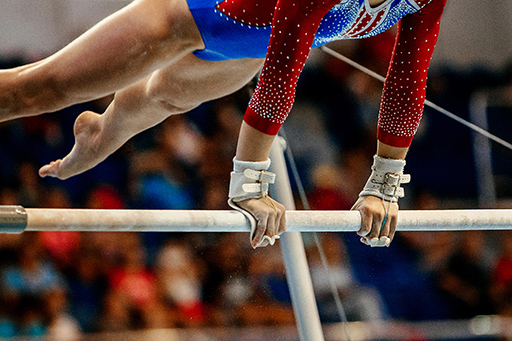4 Is ‘type of sport’ relevant?

So far you have looked at the impact that identity and level of participation may have on the way an athlete copes with transitions. But, with one sport so different from the next, does the type of sport played have an influence?
Within a team sports setting, Lagimodiere and Strachan (2015) compared the experiences of male hockey and rugby players and concluded that even within similar types of sport the transition experience can be very different especially in relation to social support networks both pre and post retirement. Within an individual sports setting, Clowes et al. (2015) looked at the transition experiences of elite female gymnasts. You look at their research in the next activity.
Activity 4 Transitions in gymnastics
Read the short summary of the study that Clowes et al. (2015) carried out and consider the following questions:
- What were the authors’ main findings connected to the experiences of the gymnasts?
- What differences do you think you may see when comparing transitions in gymnastics to other sports and why?
Discussion
The research findings suggest that gymnasts represent a vulnerable group in terms of their susceptibility to negative transitional experiences, notably retirement from sport. The authors conclude that, in part, the organisational structure of high level gymnastics is one which presents a number of unique challenges such as the early age that these athletes reach elite level. This often results in unequal power in the coach−athlete relationship which can culminate in the development of a unidimensional identity. This can be further enforced by the coach trying to reduce any other distractions for their athletes so they have a sole focus on their sport. A subsequent effect of this is that the athlete may only have support from within that sporting set up, meaning that when they leave that environment, they also leave their main or only support network.
One key difference for other sports is that often the elite level isn’t reached until much later and the athlete may have had the chance to develop a more rounded support network. Furthermore, the longevity of a career in other sports may reduce the pressure that an athlete feels. You may have also noted that other sports have a stronger social set up connected to them, for example in a team sport, which may allow reduced feelings of isolation during transition.
The findings of the Clowes et al. (2015) study reflect how within a sport with a lower peak age of performance there are potentially different challenges for athletes to negotiate. The study also reflects the importance of social support networks. This is the final influencing factor that you will look at in this session.
